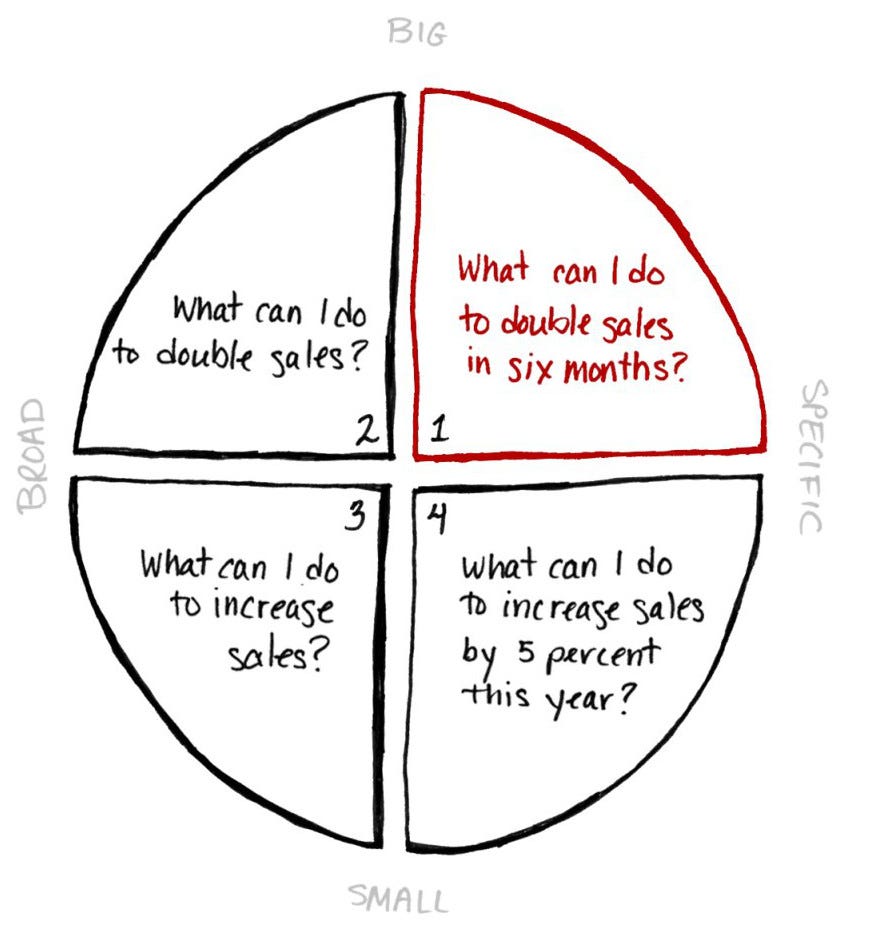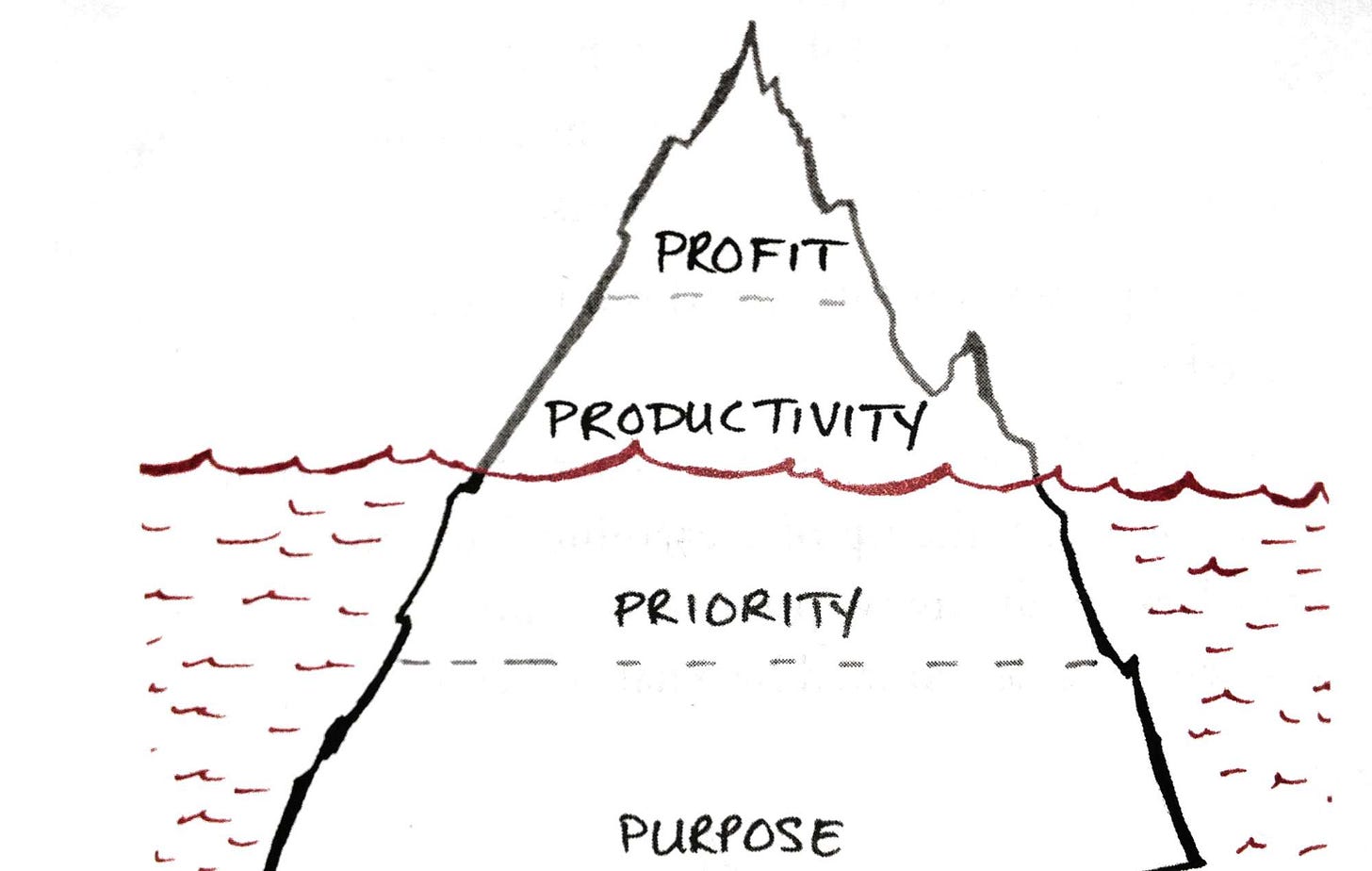The ONE Thing | Page Crimps
Key Takeaways from Gary Keller's The ONE Thing
When I first started Gary Keller’s The ONE Thing as a gift, I thought that it would be another throwaway entrepreneurial pamphlet. I was pleasantly mistaken once I started to dive in. The simple models in this book have offered long lasting wisdom that has stuck with me, now nearly a year since reading.
As usual- this excerpt is no substitute for the full read. In the book, the author offers additional context, imagery and stories that build on the points below and many more that may be just what you need to hear to narrow in on your ONE thing.
All pages reference my copy which you can find here.
p10 | Keller introduces the concept of ‘Going Small’, suggesting that extraordinary results are derived from narrow focus. Broad focus when pursuing a goal can leave you with an infinite number of paths ahead of you for what you could do next. All you really always need to be asking yourself is, what should I do next to move just one step closer to my goal?
p29 | Nonsensical common sense is how Keller describes Stephen Colbert’s idea of things that have ‘Truthiness’. Truthiness might better be described as a perspective that comes from your gut, and not from the facts of a situation.
p45 | Did you know that multitasking was originally a computer term?
Neither had I before reading this book.
Keller tells the story of how in computing, multitasking means rapidly switching between tasks on the computer’s CPU in order to mimic simultaneous function. He gives this older definition to illustrate the fallacy of believing that we can hone in on multiple complex objectives at once as a way of achieving more compared to dedicated focus on important tasks, one after the other.
On page 47, still building on the idea of multitasking as a sub-par mode of operation, the author draws a different analogy to juggling to drive the point home. In juggling, while it may sometimes look like all balls are miraculously in air in the air at the same time, there’s usually always at least one ball being tossed between hands before re-entering rotation.
p66 | Another simple model that carries a heavy point: The Willpower Gas Tank. The author references a handful of studies that suggest that our capacity to make responsible decisions starts at full and is on a constant decline as we make decision after decision, effectively running down our gas tank. One simple reference is to a study where individuals were requested to answer a number of math problems of varying difficulty for each participant and afterwards were offered either a healthy of unhealthy snack. Participants who’d used up more ‘gas’ on the difficult problems were far more likely to choose the unhealthy snack as opposed to something like an apple.
Lesson to takeaway: Know when you’re running on empty and save those decisions for tomorrow. This is why the most productive folks out there are very intentional about how they spend their high throughput time.

p93 | Keller, while highlighting some of the pitfalls of broad thinking, urges the reader to avoid thinking incrementally. When stuck and overwhelmed by how many steps are required to ‘arrive’ at your goal, just assess what’s most important, and take the one step in that direction.
p104 | A quick quote:
The quality of an answer is often determined by the quality of the question.
p121 | Keller introduces the 4 quadrants of ‘The Great Question Matrix’. To set achievable goals, you want to ask yourself and a big but also specific question. Here are some examples in each quadrant from the book —
p149 | While not a new concept to attribute to this book, I had not heard directly of the idea of hyperbolic discounting before reading it as it was introduced here. Hyperbolic discounting is the idea that the farther away a reward is in the future, the smaller one’s motivation is to achieve it.
p165 | On the subject of time blocking, the author talks about the differences between blocking time based on clock time vs event time.
An example of clock time would be: 1 hour dedicated to doing X.
Event time would be something like: I will work until I finish X.
When working towards ONE thing as the book is consistently talking about, Keller suggests time blocking 4 hours a day to work towards your biggest objective. When doing so, he also suggests to set at least one achievable event goal within that period to achieve before carrying on until the end of the time period.
p179 | What does it mean to move from E to P? Keller describes this transition as learning the path to mastery. E = entrepreneurial and P = purposeful.
The path to mastery is a combination of doing the best of what you can do and the best of what anyone can do.
p211 | Another metaphor not unique to the book but one I hadn’t heard before is the story of the 2 wolves inside of us:
An old Cherokee is teaching his grandson about life. “A fight is going on inside me,” he said to the boy. “It is a terrible fight and it is between two wolves. One is evil – he is anger, envy, sorrow, regret, greed, arrogance, self-pity, guilt, resentment, inferiority, lies, false pride, superiority, and ego.”
He continued, “The other is good – he is joy, peace, love, hope, serenity, humility, kindness, benevolence, empathy, generosity, truth, compassion, and faith. The same fight is going on inside you – and inside every other person, too.”
The grandson thought about it for a minute and then asked his grandfather, “Which wolf will win?”
The old Cherokee simply replied, “The one you feed.”
p216 | Ending with a note on interior development, I crimped this last page because I appreciated how Keller refers to success as ‘an inside job.’
He illustrates this concept by telling the story of a boy working on a challenging puzzle of the globe made out of torn newspaper bits. While it initially seemed near impossible, the boy triumphs when he notices the text and simpler image of a man on the other side. This helps him assemble the rest of the puzzle from underneath a glass table.
Sometimes when looking to enact change on the outside world, we too need to flip over the pieces of the puzzle and see where we can improve to see if it illuminates a clearer path to ultimate success.
Some thoughts on this Newsletter —
I am still honing a format for these page crimp posts. Feedback gathered over time has led to me cut back how much commentary I add to the brass tax from the books to keep them easy to digest.
My current goal is to keep all weekly posts in a 5-10 minute range for reading time. However I also want to lean in the direction of where I’m adding value to you kind folks reading my rants and ravings.
A recent idea from another writer I admire is leading me to ask- Would one longer and more thought through post every other week offer more value in exchange for your attention?

If you have input on what you’d like to see from these or future posts, feel free to engage with me on Twitter or simply comment below if you’re viewing this in your browser. For now I’m keeping up with the weekly format.
Next week, I’m going to talk about some life lessons learned from rehabbing a distressed property.
Start small and get bigger.
-Benjamin Anderson


